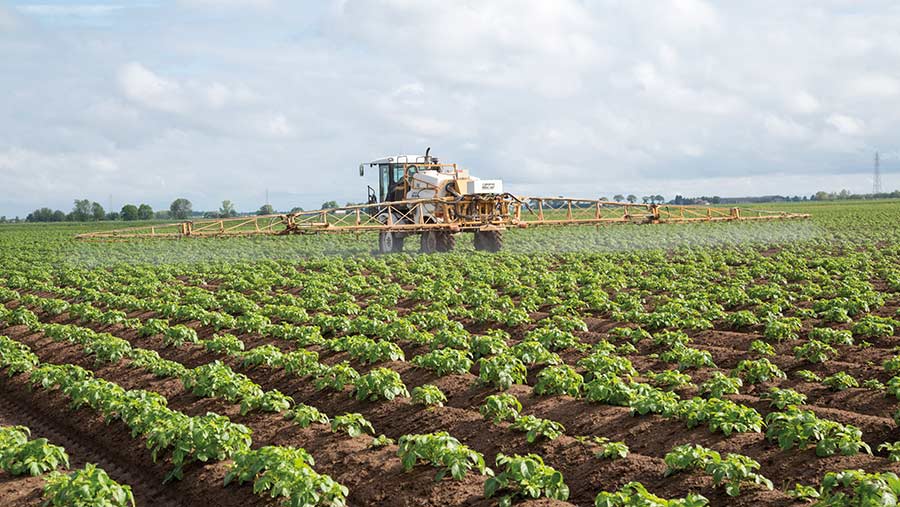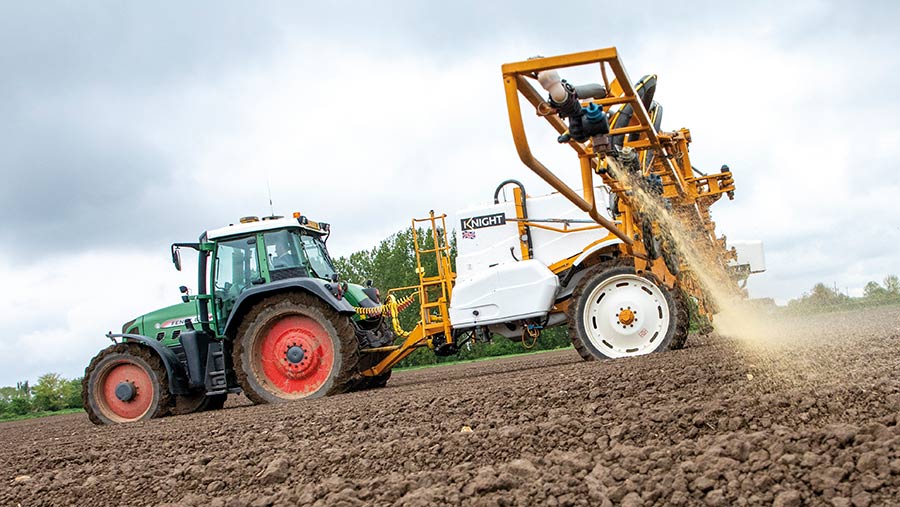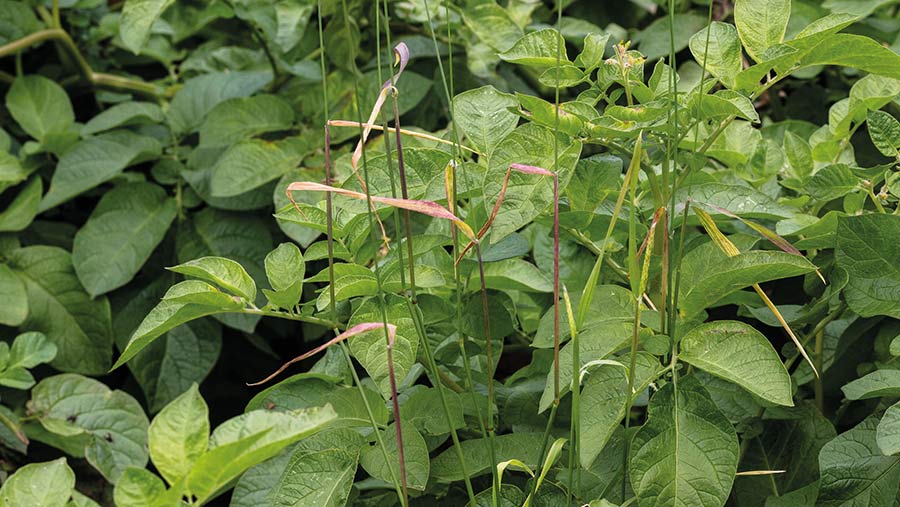How to keep potato crops free from weeds this spring
 © GNP
© GNP Potato planting has proved challenging for some and weed control could also be tricky.
Farmers Weekly gets some regional strategic advice from the Association of Independent Potato Consultants (AIPC) before crops emerge.
See also: How a trickle approach can cut potato irrigation energy costs
Martyn Cox
Blackthorn Arable, East Anglia
The first thing to consider is the contact partner for the pre-emergence residual mix, as there are differences in broad-leaved weed control between PPO-inhibitors Shark (carfentrazone-ethyl) and Gozai (pyraflufen-ethyl).
Here, we see that Gozai has the edge, particularly on groundsel, chickweed and mayweed, which can be major headaches.
A reasonable proportion of our crops are grown on sandy soils and Praxim (metobromuron) is a nice and safe residual option, as it has no soil type restrictions or varietal restrictions.
Manufacturer Certis Belchim recommends a rate between 2.5 and 3 litres/ha for best results. We tend to apply 2.5 litres/ha and partner it with prosulfocarb.
Amaranthus weeds like fat hen can be a pain and I would say that prosulfocarb adds a lot here.
Blackgrass can be a problem across the East and where it is present, adding Emerger (aclonifen) into the mix has made a big difference.
I have seen very good results on blackgrass at one-leaf stage using Emerger + metribuzin + Shark. We have also seen that aclonifen does a good job on annual mercury.
AIPC weed control advice in potatoes – key points
- Encourage rapid emergence and growth to 100% ground cover
- Know weed spectrum and tailor herbicide strategy accordingly
- Seek out weed information on rented land, particularly grassweed burden
- Focus on optimising pre-emergence control due to lack of post-emergence options
- Gozai favoured contact partner due to strengths on groundsel and chickweed
- Use Praxim on light soils and/or where a variety is sensitive to metribuzin
- Emerger a good residual option where grassweeds are present
- Flufenacet and prosulfocarb add to control of blackgrass and ryegrass
- Propaquizafop post-emergence for volunteer cereal and brome control
- Use rimsulfuron early post-emergence when weeds are small for best results
Grassweeds can be problematic at harvest – we often find that volunteer barley will emerge as the canopy opens and although still small at burn off it can get big enough to annoy harvester drivers by the time skin set is complete.
Work back from the harvest date and check product harvest interval carefully.
Propaquizafop is very useful for calming down volunteer cereals and brome, so should be considered late season.
One weed we are seeing much more of is hairy nightshade – Solanum sarrachoides – and this plant is very susceptible to blight.
I have regularly found the aggressive strain EU_36_A2 on hairy nightshade, confirmed by Fight Against Blight genotyping.
We have seen it infected with late blight before volunteer potatoes and can sit between two plants of black nightshade – Solanum nigrum – and be covered in blight while they are totally clear.
Where risk of late blight inoculum is concerned, it must rank alongside something like a volunteer King Edward.
It is not something you would want in a field edge beside potatoes and is a weed to watch.
Graeme Skinner
Provenance Potatoes, Kent

Spraying residual herbicide © GNP
The key to weed control in potatoes is knowing what the likely key weed species are in each situation.
In recent years grassweed populations have increased, initially blackgrass but more frequently Italian ryegrass.
Although it may be too late for this year, where renting land and if one is not involved with the previous combinable crops, it’s very important to confirm whether you are facing a potential grassweed issue.
Ideally, this should be done in the autumn ahead of potatoes. Look at overwintered stubbles for signs of blackgrass or other grassweed species. The key message is know what you are about to inherit.
Controlling grassweeds post-emergence of the potato crop has proven to be very variable. Rimsulfuron and metribuzin give limited control of such weeds.
ACCase-inhibiting “fops” and “dims” are again unpredictable against blackgrass and ryegrass. Cycloxydim against ryegrass can vary from a slight check of plants to good control.
That is where knowledge of a population’s resistance status can be a useful tool.
The influence of grassweeds has been the major change to my weed control strategies over recent years.
A simple, cost-effective Emerger + metribuzin mix now makes up the backbone of the residual programme, which seems robust even in dry conditions.
If problematic grassweeds are expected in a ware crop, best to be prepared and have a potato-legal pre-emergence glyphosate product in stock.
Pay close attention to the timings in terms of grassweed emergence versus potato emergence.
Alistair Neill
Prime Agriculture, East Anglia
There are plenty of challenges when it comes to weed control in potatoes, as the toolbox has been reduced over recent years.
This means an overarching strategy is needed, utilising what we have across the rotation, not just worrying about it when potatoes are planted.
The best method of weed control is a healthy canopy, so getting to 100% ground cover by appropriate cultivations, planting into good conditions and with optimal seed rates and correct nutrition should be a priority.
Cereal volunteers coming through pre-emergence herbicides, and again post-desiccation, cause issues with harvest speed and losses.
Cereal losses when combining cereal crops should be minimised where it is under your control.
Where needed, use propaquizafop pre-desiccation just as the canopy opens, but ensure that its 30-day harvest interval is abided by.
Aside from volunteer control, I believe post-emergence treatments should be avoided as much as possible, with as much emphasis placed on cost-effective pre-emergence control.
Keeping costs down relies on knowing the weed spectrum you are dealing with and recognising when and where money does need to be spent to control problem species.
For example, it is difficult to reduce spend on organic soils, where grassweeds are present or you are growing metribuzin-sensitive varieties.
A balance between crop emergence, weed emergence and soil moisture is also key in getting the most out of what is applied, which I tend to recommend in one hit just prior to crops breaking through the ridge.
On light soil types, or on metribuzin-intolerant varieties, I favour Praxim, as it has no label restrictions. It also offers good residual broad-leaved weed control.
Elsewhere, I tend to use a three-way mix of Emerger + metribuzin + Gozai. Emerger gives good activity on grassweeds and worked well on dry ridges in 2022.
Gozai is the favoured contact material because of its slightly wider weed control spectrum relative to Shark.
Where cleavers are a concern, clomazone does offer an advantage and it is worth considering an Artist mix as the main residual element where blackgrass is a major target.
Rob Blades
SPUD Agronomy, Yorkshire
The primary weed control strategy for the crop is to get plants up and away to suppress the weeds and minimise competition for light, water and nutrients.
This means it’s better to wait for the right seed-bed conditions before planting than trying to force matters.
After rain through most of March, patience will be important to avoid slow emergence, which causes multiple problems.
Growers should be ready to adjust herbicide programmes to an individual field’s needs, with an emphasis on achieving adequate broad-leaved weed control pre-emergence of the crop.
Actives
- Artist (flufenacet + metribuzin)
- Emerger (aclonifen)
- Gozai (pyraflufen)
- Praxim (metobromuron)
- Shark (carfentrazone)
Problem weeds include black bindweed and fumitory, particularly where flushes are late. Both blackgrass and ryegrass are ones to watch here in Yorkshire.
My choice on pre-emergence residual use is driven by the degree of varietal sensitivity to metribuzin, so it is important to know each variety being grown. Rates of active can then be adjusted accordingly.
Emerger has been a good addition to programmes over recent seasons, showing activity on both blackgrass and ryegrass, and prosulfocarb adds to grassweed activity where soils are moist enough to extract maximum efficacy.
Due to no varietal restrictions, Praxim is my first choice for metribuzin-sensitive varieties. It also has no restrictions on soil type and can be applied up to ridges cracking.
My contact of choice to partner the residual active substances is Gozai, adding methylated seed oil adjuvant Toil where there is a heavier weed burden.
In the right conditions, an approved glyphosate product can be added, particularly where grasses have emerged before crop emergence.
The use of a post-emergence follow-up of rimsulfuron depends on how competitive the crop and weeds are.
I only advise its use when sprayers can go early enough, which helps avoid knocking the crop and weed grasses are small enough to get the best response. Otherwise, it has a limited effect.
Some growers have used a mechanical method as a follow up to herbicide applications, and as part of the overall integrated weed control strategy, has shown to work well.
Graeme Ditty
Tame Valley Potatoes, Shropshire

Blackgrass seed head © Blackthorn Arable
Grassweeds such as ryegrass and blackgrass now present the greatest challenges for potato growers in this area. Protracted germination of ryegrass can make successful control especially difficult.
That said, all weeds can be harder to control where canopy is slow to develop and especially on high organic matter soils if the crop doesn’t achieve 100% ground cover.
Growing on rented ground can remove knowledge of the weed spectrum being inherited.
Previous crop herbicide use should be examined, which can give an indication to weed spectrum present, but such information is not always available.
Organic manures feature in many nutrient programmes in the West, which can bring added challenges by introducing weed species that might not have been a problem before.
There is a move towards applying a residual herbicide once ridges have settled, then following up with contact +/- a top-up residual where necessary.
While split applications seem to be the preferred approach with some growers, most still apply ridge weed control comprising of a contact plus residual about seven days before crop emergence.
Artist + prosulfocarb is a mixture of choice where a variety allows metribuzin. Where varieties are intolerant, prosulfocarb + pendimethalin is a good choice.
Emerger brings good levels of blackgrass reduction. Glyphosate applications to a stale seed-bed before seed-bed cultivations and, again, pre-crop and post-weed emergence are also an essential part of my blackgrass control strategy.
Use of glyphosate in this way requires careful observation of emergence patterns, particularly where seed is chitted or planting depth uneven.
Post-emergence graminicides such as propaquizafop generally provide good levels of control of volunteer cereal and brome control.
I’m also a fan of post-emergence metribuzin on tolerant varieties, as it provides useful control of black bindweed, fat hen and speedwell where these species are a problem.
Addition of water conditioner where required and adjuvant with rimsulfuron greatly improves efficacy on moderately susceptible weeds.
About the contributors
The four contributors are members of the Association of Independent Potato Consultants (AIPC).
This is a group of 18 like-minded independent agronomists and consultants, specialising in potatoes, from across England.
They meet four to five times a year to share experiences, and aim to develop and improve knowledge and understanding of the potato crop.

